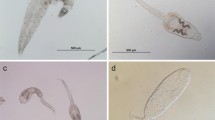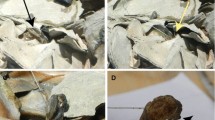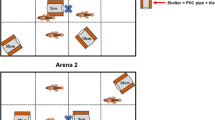Abstract
Parasites can adversely affect host population densities, but predators can regulate disease by reducing the density of susceptible hosts and consuming parasites contained in infected hosts. Some parasites induce phenotypic modifications in their hosts that potentially lead to increased predation. We investigated the role of parasite-induced modified appearance in the interactions between the crustacean Daphnia magna, its bacterial parasite Pasteuria ramosa, and its predator, the backswimmer Anisops sp. Our aim was to test the backswimmer’s prey preference between infected and uninfected D. magna to find out whether infection by P. ramosa can affect predation risk by Anisops. We found that Anisops sp. had a strong preference for uninfected D. magna under light, but under dark conditions the preference was reversed, which suggests that the modified appearance is the cause of this preference. Such anti-parasite preference by Anisops sp. could strongly influence host population dynamics as loss of fecundity, disease mortality, and predation are additive, resulting in host population decline.



Similar content being viewed by others
References
Alizon, S., A. Hurford, N. Mideo & M. Van Baalen, 2009. Virulence evolution and the trade-off hypothesis: history, current state of affairs and the future. Journal of Evolutionary Biology 22(2): 245–259.
Anderson, R. M. & R. M. May, 1981. The population dynamics of microparasites and their invertebrate hosts. Philosophical Transactions of the Royal Society of London Series B: Biological Sciences 291(1054): 451–524.
Anderson, R. M. & R. M. May, 1982. Coevolution of hosts and parasites. Parasitology 85(2): 411–426.
Ben-Ami, F. & J. Routtu, 2013. The expression and evolution of virulence in multiple infections: the role of specificity, relative virulence and relative dose. BMC Evolutionary Biology 13: 97.
Ben-Ami, F., L. Mouton & D. Ebert, 2008. The effects of multiple infections on the expression and evolution of virulence in a Daphnia-endoparasite system. Evolution 62(7): 1700–1711.
Bittner, K., K.-O. Rothhaupt & D. Ebert, 2002. Ecological interactions of the microparasite Caullerya mesnili and its host Daphnia galeata. Limnology and Oceanography Methods 47(1): 300–305.
Carius, H. J., T. J. Little & D. Ebert, 2001. Genetic variation in a host-parasite association: potential for coevolution and frequency-dependent selection. Evolution 55(6): 1136–1145.
Chesson, J., 1983. The estimation and analysis of preference and its relationship to foraging models. Ecology 64(5): 1297–1304.
Choo, K., P. D. Williams & T. Day, 2003. Host mortality, predation and the evolution of parasite virulence. Ecology Letters 6(4): 310–315.
Day, T., 2002. Virulence evolution via host exploitation and toxin production in spore-producing pathogens. Ecology Letters 5(4): 471–476.
Decaestecker, E., L. De Meester & D. Ebert, 2002. In deep trouble: habitat selection constrained by multiple enemies in zooplankton. Proceedings of the National Academy of Sciences of the Unites States of America 99(8): 5481–5485.
Diéguez, M. C. & J. J. Gilbert, 2003. Predation by Buenoa macrotibialis (Insecta, Hemiptera) on zooplankton: effect of light on selection and consumption of prey. Journal of Plankton Research 25(7): 759–769.
Duffy, M. A. & S. R. Hall, 2008. Selective predation and rapid evolution can jointly dampen effects of virulent parasites on Daphnia populations. The American Naturalist 171(4): 499–510.
Duffy, M. A., S. R. Hall, A. J. Tessier & M. Huebner, 2005. Selective predators and their parasitized prey: are epidemics in zooplankton under top-down control? Limnology and Oceanography 50(2): 412–420.
Ebert, D., 2005. Ecology, epidemiology and evolution of parasitism in Daphnia [Internet]. National Library of Medicine (US), National Center for Biotechnology Bethesda, MD.
Ebert, D., 2008. Host-parasite coevolution: insights from the Daphnia-parasite model system. Current Opinions in Microbiology 11(3): 290–301.
Ebert, D. & W. W. Weisser, 1997. Optimal killing for obligate killers: the evolution of life histories and virulence of semelparous parasites. Proceedings of the Royal Society of London Series B: Biological Sciences 264(1384): 985–991.
Ebert, D., P. Rainey, T. M. Embley & D. Scholz, 1996. Development, life cycle, ultrastructure and phylogenetic position of Pasteuria ramosa Metchnikoff 1888: rediscovery of an obligate endoparasite of Daphnia magna Straus. Philosophical Transactions of the Royal Society of London Series B: Biological Sciences 351(1348): 1689–1701.
Ebert, D., D. Duneau, M. D. Hall, P. Luijckx, J. P. Andras, L. Du Pasquier & F. Ben-Ami, in press. A population biology perspective on the stepwise infection process of the bacterial pathogen Pasteuria ramosa in Daphnia. Advances in Parasitology.
Eitam, A., L. Blaustein & M. Mangel, 2002. Effects of Anisops sardea (Hemiptera: Notonectidae) on oviposition habitat selection by mosquitoes and other dipterans and on community structure in artificial pools. Hydrobiologia 485(1–3): 183–189.
Fels, D., V. A. Lee & D. Ebert, 2004. The impact of microparasites on the vertical distribution of Daphnia magna. Archiv für Hydrobiologie 161(1): 65–80.
Giller, P. S. & S. McNeill, 1981. Predation strategies, resource partitioning and habitat selection in Notonecta (Hemiptera/Heteroptera). Journal of Animal Ecology 50(3): 789–808.
Goren, L. & F. Ben-Ami, 2013. Ecological correlates between cladocerans and their endoparasites from permanent and rain pools: patterns in community composition and diversity. Hydrobiologia 701(1): 13–23.
Green, J., 1974. Parasites and epibionts of Cladocera. The Transactions of the Zoological Society of London 32(6): 417–515.
Hulscher, J. B., 1982. The Oystercatcher Haematopus ostralegus as a predator of the bivalve Macoma balthica in the Dutch Wadden Sea. Ardea 70: 89–152.
Izhar, R. & F. Ben-Ami, 2015. Host age modulates parasite infectivity, virulence and reproduction. Journal of Animal Ecology 84(4): 1018–1028.
Jensen, K., T. J. Little, A. Skorping & D. Ebert, 2006. Empirical support for optimal virulence in a castrating parasite. PLoS Biology 4(7): e197.
Johnson, P. T., D. E. Stanton, E. R. Preu, K. J. Forshay & S. R. Carpenter, 2006. Dining on disease: how interactions between infection and environment affect predation risk. Ecology 87(8): 1973–1980.
Johnson, P. T., A. Dobson, K. D. Lafferty, D. J. Marcogliese, J. Memmott, S. A. Orlofske, R. Poulin & D. W. Thieltges, 2010. When parasites become prey: ecological and epidemiological significance of eating parasites. Trends in Ecology & Evolution 25(6): 362–371.
King, K. C., S. K. Auld, P. J. Wilson, J. James & T. J. Little, 2013. The bacterial parasite Pasteuria ramosa is not killed if it fails to infect: implications for coevolution. Ecology and Evolution 3(2): 197–203.
Klüttgen, B., U. Duulmer, M. Engels & H. T. Ratte, 1994. ADaM, an artificial freshwater for the culture of zooplankton. Water Research 28(3): 743–746.
Lafferty, K. D., 1992. Foraging on prey that are modified by parasites. The American Naturalist 140(5): 854–867.
Lafferty, K. D., 1999. The evolution of trophic transmission. Parasitology Today 15(3): 111–115.
Manly, B. F., 1974. A model for certain types of selection experiments. Biometrics 30(2): 281–294.
Manly, B. F., 1995. Measuring selectivity from multiple choice feeding-preference experiments. Biometrics 51(2): 709–715.
Mazzi, D. & T. Bakker, 2003. A predator’s dilemma: prey choice and parasite susceptibility in three-spined sticklebacks. Parasitology 126(4): 339–347.
Médoc, V., L. Bollache & J.-N. Beisel, 2006. Host manipulation of a freshwater crustacean (Gammarus roeseli) by an acanthocephalan parasite (Polymorphus minutus) in a biological invasion context. International Journal for Parasitology 36(13): 1351–1358.
Médoc, V., T. Rigaud, L. Bollache & J.-N. Beisel, 2009. A manipulative parasite increasing an antipredator response decreases its vulnerability to a nonhost predator. Animal Behaviour 77(5): 1235–1241.
Møller, A. P., 1998. Interactions between interactions: predator-prey, parasite, host and mutualistic interactions. New York Academy of Science 1133: 180–186.
Møller, A. P., J. Erritzøe & J. N. Nielsen, 2010. Predators and microorganisms of prey: goshawks prefer prey with small uropygial glands. Functional Ecology 24(3): 608–613.
Moore, J., 1983. Responses of an avian predator and its isopod prey to an acanthocephalan parasite. Ecology 64(5): 1000–1015.
Murphey, R. & B. Mendenhall, 1973. Localization of receptors controlling orientation to prey by the Back Swimmer Notonecta undulata. Journal of Comparative Physiology 84(1): 19–30.
Packer, C., R. D. Holt, P. J. Hudson, K. D. Lafferty & A. P. Dobson, 2003. Keeping the herds healthy and alert: implications of predator control for infectious disease. Ecology Letters 6(9): 797–802.
Poulin, R., 2006. Evolutionary Ecology of Parasites. Princeton University Press, Princeton, NJ.
Poulin, R., 2011. The many roads to parasitism: a tale of convergence. Advances in Parasitology 74: 1–40.
Reynolds, J. G. & M. C. Geddes, 1984. Functional response analysis of size-selective predation by the notonectid predator Anisops deanei (Brooks) on Daphnia thomsoni (Sars). Australian Journal of Marine and Freshwater Research 35(6): 725–733.
Sano, K. & H. Kurokura, 2011. Predatory behavior of the backswimmer (Anisops ogasawarensis) on larval medaka (Oryzias latipes). Aquaculture 317(1): 210–213.
Schmid-Hempel, P., 2011. Evolutionary Parasitology: The Integrated Study of Infections, Immunology, Ecology, and Genetics. Oxford University Press, New York.
Van Essen, F. W. & D. W. Anthony, 1976. Susceptibility of nontarget organisms to Nosema algerae (Microsporida: Nosematidae), a parasite of mosquitoes. Journal of Invertebrate Pathology 28(1): 77–85.
Acknowledgment
We are grateful to A. Petrusek and two anonymous reviewers for very helpful comments.
Author information
Authors and Affiliations
Corresponding author
Additional information
Guest editors: Adam Petrusek & Piet Spaak / Proceedings of the 10th International Symposium on Cladocera
Rights and permissions
About this article
Cite this article
Goren, L., Ben-Ami, F. To eat or not to eat infected food: a bug’s dilemma. Hydrobiologia 798, 25–32 (2017). https://doi.org/10.1007/s10750-015-2373-3
Received:
Revised:
Accepted:
Published:
Issue Date:
DOI: https://doi.org/10.1007/s10750-015-2373-3




